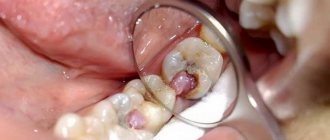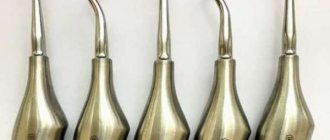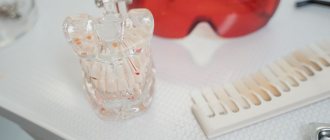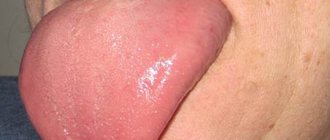Advanced caries, which makes itself felt through prolonged aching pain, is one of the most common reasons to visit the dentist. This clinical picture forces the doctor to resort to the only method of tooth restoration known today - filling. Many are familiar with this procedure and are confident that the problem can be solved in one go. Imagine the patient’s surprise when it turns out that a temporary filling is being installed and the day after tomorrow he will need to sit in the dental chair again.
It has a special composition and is intended to temporarily cover dental tissues and isolate them from external influences. The key phrase in this case is for a while and often for a very short time. We are talking about two to three days; less often, a temporary filling can remain in the tooth for several weeks. How long you can walk with a temporary filling is not up to the patient, but to the attending physician. After the period strictly determined by the dentist, it must be removed and replaced with a permanent one.
How to determine if a filling has fallen out
Often, after going to the dentist, people find themselves in a situation where the integrity of the filling begins to be questioned. And sometimes it is not immediately possible to notice that the filling will soon fall out or has already fallen out.
If it seems to you that the filling has fallen out, try to feel the place where it was with the tip of your tongue and determine by the sensations whether the filling is in place or has flown out.
If your filling still falls out, do not take any independent measures under any circumstances and immediately contact your dentist! Independent intervention can lead to very unpleasant consequences, since the filling cavity is very vulnerable to bacteria and it would be a completely wrong step to neglect this advice.
Therefore, if a filling falls out or becomes loose, you need to contact a dentist as soon as possible for professional advice and reinstallation of the filling.
Signs of a filling falling out soon
How can you tell if a filling has fallen out? This is quite simple - at the place of its installation there is no material with which the filling was made, and there is a hole. Therefore, it is better to prevent such a phenomenon and contact a specialist in advance, even before complete loss.
Determining that the filling does not stay in the tooth and will soon fall out is also quite simple. Gaps appear between the tooth surface and the filling material, which are almost invisible at first, but become larger over time. The material itself becomes loose. This is felt when you press the seal with your tongue. If such phenomena are observed, you should immediately consult a doctor so as not to be annoyed later that the filling has come out.
What to do if a filling falls out and your tooth hurts
A filling falling out of a tooth can also often be accompanied by pain. If you find that after “losing” a filling, your tooth is bleeding, or you simply experience unpleasant or acute pain, and there is no opportunity to see a doctor, you can numb the aching tooth yourself at home.
One of the main ways is painkillers! Yes Yes! Exactly! However, the tablet should not be chewed, swallowed, or taken with water as usual. The only and surest way is to hold an analgin tablet (for example) near a sore tooth until it completely dissolves.
By breaking down, the soothing properties of the tablet penetrate into the filling cavity, bringing the nerve into a calmer state, soothing and comforting the pain threshold of the tooth surface. And you don’t have to worry about the filling falling out, since a professional dentist can easily and quickly correct this unpleasant situation.
And remember! Do not try to replace a fallen filling under any circumstances, as this may lead to deterioration of the tooth surface.
Price for dental treatment in Kazan
| Service | Price |
| Treatment of superficial and medium caries | 2500 rub. |
| Treatment of deep caries | 2800 rub. |
| Treatment of pulpitis of a single-rooted tooth | 2300 rub. |
| Treatment of pulpitis of a two-root tooth | 3300 rub. |
| Treatment of pulpitis of a three-root tooth | 4300 rub. |
| Treatment of periodontitis of a single-rooted tooth in one visit | 2600 rub. |
| Treatment of periodontitis of a two-root tooth in one visit | 3600 rub. |
| Treatment of periodontitis of a three-root tooth in one visit | 4600 rub. |
Is it possible to seal the hole?
Also, when a filling falls out, many often wonder what can be used to seal or seal it, or to plug the tooth, before visiting the dentist. But here it is worth learning one simple truth - you will not be able to solve this problem on your own!
If a filling falls out, you should immediately consult a dentist and do not try to close the tooth yourself. The result of such independent treatment may not be very promising. For example, you can easily get an infection or damage the cavity for the filling, as a result of which the pain may significantly worsen.
Relieving toothache is not a problem today! However, these are all extreme measures that do not replace a visit to the dentist, but only delay it. Therefore, remember that any independent intervention can always lead to very unpleasant consequences.
If this problem happens to you, be sure to thoroughly clean the cavity of the filling, make sure that no food gets in there, and do not put pieces of garlic or onion into the cavity. Take care of yourself and do not delay visiting your doctor.
Can arsenic harm the body?
If a nerve is inflamed, only a doctor can help. Treatment of pulpitis may include healing procedures or removal of pathological tissue. The choice depends on the stage of the lesion. If you contact the dentist right away, you can stop the inflammation process while preserving the nerve. The essence of surgical technologies is partial or complete removal of the pathological pulp.
Many patients are frightened by the loss of glue placed in the cavity of the unit for a certain period. It happens that patients accidentally swallow it. This will not lead to perforation of internal systems and organs, and the inflammatory process will not start from this. Arsenic is almost never used in the practice of modern dentists. Today, dentists are increasingly using special pastes that contain a small amount of the chemical element. The substance works as a necrotizing mixture. Such a dose is not capable of leading to poisoning.
If ingestion cannot be avoided, contact your dentist. Before seeing a doctor, call him and describe the situation to him. The doctor will tell you what actions you should take, because he is familiar with the problem. An unscheduled visit may be scheduled for re-filling. If there is no danger, the visit may take place on the previously planned day.
How long can you walk without a filling?
All fillings, as you know, come in two types: temporary and permanent. The temporary one is set for no more than five days. For example, in cases where it is necessary for the medicine to get into the tooth cavity and not be washed out by saliva. In the event that a temporary filling falls out, it is necessary to consult a doctor as soon as possible, because the seal of the filling cavity is broken, as a result of which bacteria and food debris can get inside the tooth, which can lead to inflammation and acute toothache. However, the temporary filling itself requires a visit to the doctor to replace it, so its loss does not cause much harm.
The situation becomes more serious when a permanent filling falls out. There are many reasons why a permanent filling falls out. All subsequent treatment, its complexity and cost depend on them.
The loss of a permanent filling can lead to various troubles, including difficulties in cleaning and hygiene, since you will not be able to fully clean this tooth. In addition, you will begin to avoid chewing food with the side on which the diseased tooth is located, which will transfer the entire load to the other side of the jaw, so you can’t live with a fallen filling for a long time.
Indications for installing a temporary filling
Some patients are sincerely perplexed and consider temporary filling an unnecessary measure. However, in fact, this is a very important stage in the treatment of teeth affected by deep caries, pulpitis, periodontitis, as well as in the presence of abscesses, cysts and granulomas.
The photo shows a temporary filling
The doctor resorts to temporary filling if it is not possible to carry out treatment in one stage or the inflammation needs to be eliminated. They also resort to a temporary solution while stump inlays and permanent prostheses are created for the patient in the laboratory. The filling serves as protection against external factors and bacteria. It prevents medications and antiseptics from coming out, which are placed inside the root canals and have a therapeutic effect.
“The doctor gave me a temporary filling just to see how the tooth would behave and whether complications would begin after treatment of deep caries. I carried it for about 5 days with severe pain, and then it fell out, after which the doctor said that we would remove the nerve from the tooth...”
Nadezhda, review from yell.ru
How will a fallen filling be treated?
The solution to this problem is not difficult. The dentist will solve it very simply. Of course, in such a situation, everyone has many questions, such as whether the treatment is painful, or whether the tooth will be drilled. Let's look at what measures the doctor will take and how all the procedures are carried out step by step.
First, the doctor will prepare the carious cavity of the tooth. Using metal and diamond burs, the doctor will remove all tooth tissue affected by caries. This procedure requires special care, because the remains of caries can provoke its re-development. Even if the most expensive materials are used to fill such a cavity, there is no guarantee that the filling will last long. In this case, caries will continue to progress.
The second thing the dentist will do is correct formation of the dental cavity. Each material has its own requirements for the formation of a dental cavity for a filling.
Due to the doctor’s haste, many extremely important stages of restoration may be missed or carried out in bad faith, so for restoration and re-filling it is worth paying special attention to the choice of a specialist.
Measures to help prevent temporary fillings from falling out
In order not to think about what to do if a temporary filling falls out, try to prevent such a situation after its installation. To do this you need to adhere to the following rules:
- in the first 2 hours after installation, refrain from eating any food so that the materials finally harden and acquire the desired shape,
- exclude hard foods, nuts, and sticky foods from your diet: temporary fillings are softer than permanent fillings, they can easily crumble, break off or fall out,
- try to chew on the side opposite to the one where the treatment was carried out,
- refuse to use irrigator and floss in the area of localization of temporary materials,
- Carefully inspect the seal every day for chips and cracks: if even small leaks appear, you should consult a doctor.
Eliminate solid foods from your diet
As you can see, there is nothing difficult about keeping a temporary filling in place. If it falls out before the scheduled visit to the dentist, then there is nothing to worry about in this situation, provided that you act correctly and do not put off going to the doctor for a long time.
Notice
: Undefined variable: post_id in
/home/c/ch75405/public_html/wp-content/themes/UltraSmile/single-item.php
on line
45 Notice
: Undefined variable: full in
/home/c/ch75405/public_html/wp-content /themes/UltraSmile/single-item.php
on line
46
Rate this article:
( 7 ratings, average: 4.00 out of 5)
dental fillings
- Fedorinchik O.V. Frequency of use of calcium hydroxide preparations by dentists in the treatment of complicated caries. – Modern dentistry, 2011.
Expert “A temporary filling is not intended for long-term use, so if the doctor installs it, he must inform the patient when the next visit to the clinic needs to be made for removal or replacement. But not all people come on the appointed day, some postpone the issue for a week or even longer - and this explains why the integrity and tightness of the material is gradually being compromised.” Dentist-therapist Elena Vladimirovna Orlova
Consulting specialist
Orlova Elena Vladimirovna
Doctor rating: 9.5 out of 10 (2) Specialization: Dentist-therapist Experience: 33 years
What to do if a temporary filling falls out
As already mentioned, the loss of a temporary filling does not have any serious consequences. However, if such an unpleasant situation arises, it is worth paying careful attention to hygiene and dental care before going to the dentist, since if the canals were sealed in bad faith, bacteria could accumulate inside.
Try not to chew food on the side of the diseased tooth, and do not put any folk remedies into the hole of the tooth.
The loss of a temporary filling occurs due to poor-quality materials that were used for filling, its unprofessional installation, or due to the fault of the patient himself, but one way or another, the most correct decision in this difficult situation would be to make an appointment with the doctor who installed the filling for you .
The use of a temporary filling is a fairly popular and widespread phenomenon, and sometimes inevitable. The time that the patient must wear a temporary filling is most often determined by a specialist. Do not forget that you need to wear a temporary filling exactly as long as it was determined by your doctor, since any duration of a temporary filling depends only on the pathologies of your individual case.
Destruction of the seal
Has the filling broken? This is evidence of its gradual destruction. This phenomenon can occur for various reasons. The main ones:
- Too much zeal when carrying out hygiene procedures. Frequent use of a hard brush can cause damage to the filling material or enamel.
- Large loads on the tooth. They occur when eating solid foods, seeds, nuts and the like.
- Poor quality filling material.
- Failure of a specialist to comply with the technological process.
What to do if a piece of the filling breaks off and your tooth hurts? This indicates that the material does not adhere tightly to the surface and a gap has arisen between the filling and the tooth. Pain is a consequence of the inflammatory process. If the pathology is not eliminated, it will develop and cause various diseases.
If a filling breaks on a dead tooth, a crown will have to be placed in any case. If a problem arises on a front tooth that is still alive, the doctor will suggest depulping it and then installing a crown as well.
A child's filling fell out
And of course, we cannot fail to mention the loss of fillings in children. Caries and its treatment in baby teeth are often complicated by several reasons, including the child’s young age, or fear of the dentist.
Caries on baby teeth develops quite rapidly. That is why hygiene of baby teeth in children should be a high priority. If you really monitor the health of your child’s teeth and follow all the necessary hygiene and preventive measures, then treatment and installation of a filling will not take more than 30-40 minutes.
You can often hear stories about how a doctor cured two teeth for a child in 15 minutes. It should be understood that dental treatment is a rather complex process and requires some time, and each stage must be performed carefully and professionally. Fast work in this case cannot be an indicator of quality and skill. Take care of the health of your children, do not allow yourself to be misled. You have the right to demand from the doctor conscientiousness and honest performance of his work!
Tip #2: Don’t rely on recommendations from online forums
A temporary filling has fallen out and you don’t know what to do in this situation? First of all, give up the idea of taking advantage of the dangerous recommendations of some Internet users. Under no circumstances should you do the following:
- cover the resulting cavity with chewing gum: you can introduce infection inside,
- pick out the remains of the filling and the medicine inside with a needle or other sharp objects: there is a high probability of damage to the soft tissues of the oral cavity. During the manipulation, there is a risk of breaking the needle, and it will be impossible to pull out the fragment on your own, which will lead to the development of inflammation. The use of sharp objects is fraught with the exact opposite effect - you will drive deeper the remains of the medicine and bacteria from the external environment,
- put antibiotics or tablets inside yourself: this can increase the pain and worsen the condition of the pulp, dentin and surrounding tissues.
Don't pick your teeth yourself
What to do if a filling falls out during pregnancy
The natural defense and immunity of a pregnant woman is greatly reduced, for this reason, during pregnancy, women are at increased risk for various diseases. The fetus needs a huge amount of minerals and various nutrients, and if a woman does not receive these vitamins, then the fetus makes up for its deficiency from the reserve resources of the mother’s body. As a consequence of this, a woman lacks calcium to meet her body's needs.
Therefore, a common question that women ask is whether it is acceptable to get a filling during pregnancy?
When a woman is carrying a baby, dental treatment is a fairly important and time-consuming process, since many drugs tend to penetrate the placenta and can cause irreparable harm to the baby.
General anesthesia is a fairly safe method, and with one injection you can easily numb the problem tooth. But for pain relief for pregnant women, the necessary drug will have to be selected individually and especially carefully so as not to harm the fetus and its mother. However, modern equipment has a fairly targeted effect on the diseased tooth. Also, treatment of a diseased tooth may be delayed. If the situation allows it, then, of course, it would be more advisable to postpone dental treatment until after childbirth.
Filling falling out during pregnancy
When a temporary filling falls out during pregnancy, this is a reason to urgently consult a dentist. Many women worry that treatment may negatively affect the course of pregnancy. Women carrying a child are certainly at risk, but doctors are well aware of the acceptable limits of exposure. If necessary, the doctor will select the optimal method of intervention so as not to harm the body.
You need to treat your teeth anyway. Carious lesions are an ideal environment for the development of pathogens that can cause much more harm to a pregnant woman than the process of restoring a diseased tooth.
If a filling falls out at the end of pregnancy - in the 3rd trimester, the doctor may postpone treatment if serious intervention is necessary to restore the tooth. In most cases, the specialist will make do with minimal temporary treatment, and will carry out complex measures carried out under anesthesia after childbirth.
A case where the filling partially broke off
Quite often, the material that makes up the filling begins to crumble and collapse. Let's look at cases of seal failure, and what needs to be done in these cases?
This often happens when low-quality materials are used, or the dentist simply does not follow all the necessary rules for preparing the tooth for filling. Often the filling is destroyed due to the fault of the patient himself. When using low-quality material with a low degree of strength, adhesion to tooth tissue is reduced, which often results in the formation of a gap, which undoubtedly leads to the re-development of caries.
It is also impossible to exclude the shelf life and operation of the filling material. Depending on the material used for filling, the lifespan of the filling varies significantly. However, if a composite that has already expired is installed, the filling may break literally immediately, or within a couple of days or weeks.
If you find a piece of filling on a dead tooth, or it is broken or falls out, you should immediately consult a doctor, preferably the one who installed the filling. But before you contact the dentist, you need to make sure and make sure what material has broken off, temporary or permanent, since all further actions of the dentist depend on this.
Why do fillings fall out?
The main reason is poor material used to fill the canal or insufficient qualifications of the dentist who performed the treatment.
Why do teeth break off along with the filling:
- Wrong choice of materials. Using cheap cement. The filling falls off, and bacteria penetrate into the microcracks, causing the development of pulpitis, caries, and periodontal disease.
- Illiterate canal filling. If installed incorrectly, cracks appear and microbes and food penetrate inside the tooth, which leads to caries.
- The molars were processed poorly. If a tooth breaks off along with a filling, this may indicate improper cleaning of the surface from carious formations.
- Incorrectly performed preparatory stage, treatment. The molar cavity is not sufficiently dry and is treated with a solution.
- Thin dentin and enamel due to lack of calcium.
- End of service life of filling material.
- Solid food, candy, seeds, the habit of chewing a pencil, pen. Constant mechanical impact negatively affects the condition of molars.
Attention! If a filling breaks, this may indicate poor oral hygiene. Deposits and plaque formed in the absence of brushing the teeth contribute to the accumulation of pathogenic bacteria and lead to the development of caries.
The filling fell out and the tooth chipped
The main hardness of the dental coating is given by mineral substances, which include: eight-calcium phosphate, hydroxyapatite, chloride and carbonate apatites.
Among the reasons why teeth may lose their natural strength are:
- unbalanced and unhealthy diet;
- age-related and other changes affecting the integrity of calcium tissues;
- disruption of intestinal function, as a result of which the absorption of minerals changes significantly;
- deviations caused by hormonal imbalances;
- Increased acidity of the oral cavity also affects the strength of the enamel.
Excessive load that occurs under the following circumstances can lead to tooth chipping:
- injuries resulting from falls;
- malocclusion;
- cracking nuts, or opening bottles with teeth;
- close contact of the teeth with fruit seeds, fish bones, chicken bones, and other hard food particles.
Provoking factors:
- weakening of the strength of teeth can also occur after removal of the nerve, since in this case the tooth becomes almost dead;
- Regular consumption of sweet, sour foods, or carbonated drinks
- insufficient oral care, as a result of which harmful bacteria accumulate in the oral cavity;
- temperature changes when eating hot food after cold food, and vice versa;
For your peace of mind, it is recommended to contact a good dental clinic.
Signs that a filling is about to fall out
The first symptoms of impending filling loss may be discomfort during chewing - an unpleasant feeling of “sand on the teeth.” Microgaps between the filling compound and the tooth accumulate food debris, which also causes discomfort. If you have the opportunity to examine the tooth yourself, then, as a rule, you will notice that the filling has begun to partially collapse. The gaps between the tooth and the filling gradually widen, and the filling begins to wobble, which is clearly felt by the tongue if you press the filling with it.











